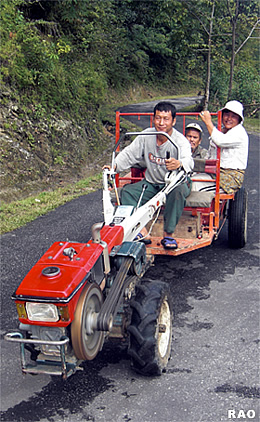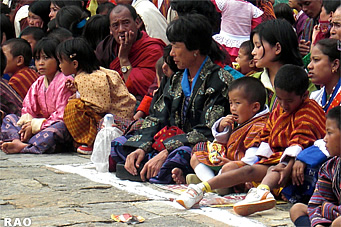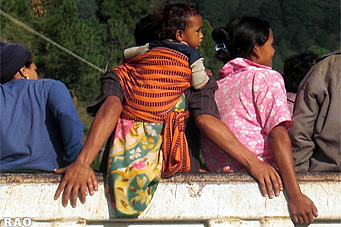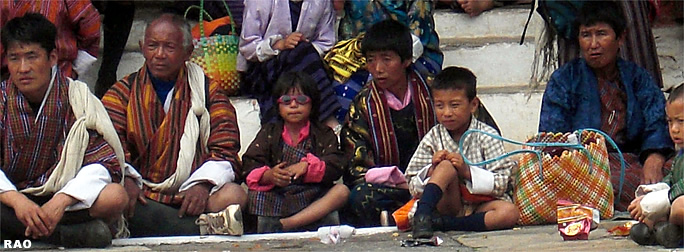|
A
tradition under change: Marriage in Estern Bhutan
|
 |
Bhutan People |
 |
Bhutan Information |
|
|
|
 |
|
Serga
mathang and serga khothkin in Eastern Bhutan
|
 |
 |
| Serga
mathang and Serga khothkin are Tsangla (dialect spoken in eastern
Bhutan) phrases, literally meaning "golden cousin" and pertain to
consanguineous marriage. As it suggests, marriage among immediate cross
cousins is comparable to amassing a coveted gold. Serga mathang is an expression
for the daughter of one's father's sister or of one's mother's brother.
Mathang
is a term associated with female cross cousin. Similarly, Serga khothkin
applies to male cousin. The cross cousins' parents are called serga
ani (aunt) and serga ajang (uncle).
Cross cousin marriage takes
place between serga mathang and khothkin. The marriages among parallel
cousins are very rare. They are equated to progenies of the same parents
and hence considered as incest.
However,
there are some cases of parallel cousin marriages. Cross cousin marriage
is forbidden by social precepts and is a social taboo in western Bhutan.
However, an aphorism that "the nephew deserved his maternal uncle's daughter"
points to the existence of cross cousin marriage both in western and central
Bhutan. |
|
The
institution of marriage is influenced by cross cousin rules, which specify
that a man should marry his cousin of different parentage, who are biologically
related : matrilateral, patrilateral and bilateral cousins. In eastern
Bhutan, all three types of cousin marriages are present, and female cousin
in all three is referred as serga mathang. Bilateral cousin marriages are
considered to be the best of all. The presence of an elaborate system of
marriages within kinship members serve to maintain alliances and exchanges
between biologically related groups.
Rural
people in eastern Bhutan are particular about their matrimonial alliances.
They favour endogamy, which is a bonding factor for communal identity and
social organisation. In a sharchop society, marriages among relatives are
considered as ideal and continue to remain entangled in the web of social
structure. The popularity of such alliances can be associated with a variety
of social, cultural and economic advantages. But there is today an increasing
doubt cast on the serga mathang concept, as a social impediment, on moral
and medical grounds. As liberal ideas of love and individual choice penetrate
deeper into the rural communities, this tradition is already in retreat.
Those whose spouse choice is influenced by new attitude prefer mate selection
based upon romance, intimacy and compatibility. Social status, wealth and
value of the immediate cousins no longer incline them to marry their cousins.
top
|
Possible
Origins of Serga Mathang Custom
|
 |
There
are no reliable records depicting the historical beginning of this marital
custom. Tsangla people believe that they are the descendants of the six
ruling clans who are descendants of Tsangma, the son of Gyalpo Thrisong
Detshen. This endogamous marriage might have got entrenched within the
tsangla community mainly to maintain the communal identity and perpetuate
lineage. Another assumption is that, in medieval Bhutan, there were different
groupings based on ethnic differences. Intermarriage among various groups
might have been discouraged. Marriage between nobilities and commoners
were rare. The families of nobility preferred marriage within their own
group. This might have restricted marriage within the close relatives.
Cultural
and physical isolations of one village from another due to geographical
barriers might have reinforced endogamy tradition. An arranged marriage
based on close ethnic ties used to be popular in olden days. Neighbour
married neighbour for many generations. The segregation of different communities
by various barriers inevitably forced each secluded community to confine
their marriages within themselves. Cross cousins were allowed to marry
each other even in western Bhutan. The social stigma imposed on cross cousin
marriages in this part of the country seems to have been introduced recently.
Change in this practice can be partly attributed to modern legal and social
concepts.
| This
article was contributed by KUENSEL, Bhutan's National Newspaper |
 |
| Information on Bhutan |
 |
|




